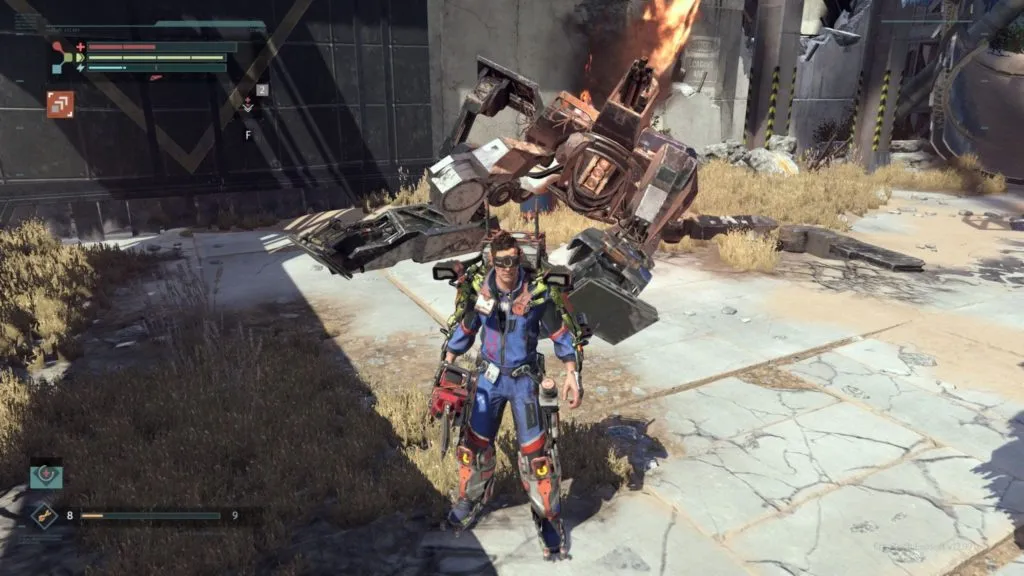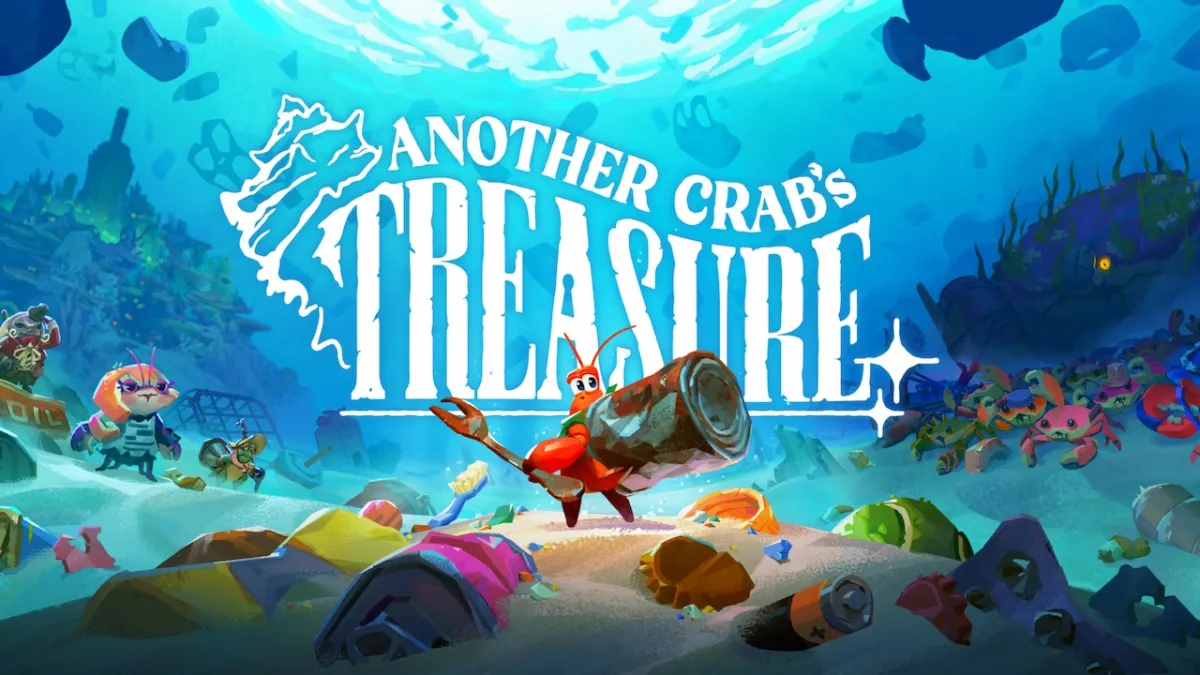I haven’t even started writing this review, and I hate it already. I hate it because I know I’m going to spend enough time comparing The Surge to Dark Souls that I’m practically going to be reviewing Dark Souls. The problem is that there aren’t a great deal of balls-hard third-person action-RPGs in which death is a major setback that makes you drop your experience tokens and money, every enemy is a threat, and exploration is as important as it is dangerous. So, to analyse what The Surge gets right (and wrong), comparing it to the genre’s masterpiece is pretty much a given. And that annoys me.
I suppose I could compare it to Deck13’s previous title, Lords of the Fallen, but I didn’t really play that. So, uh, that’s out. I’m also going to complain a lot despite the fact that I actually kinda like The Surge, and that annoys me as well. That weird noise you hear is me sighing, but I’m going to do my damnedest to keep the Souls comparisons to a minimum.
Things start well, anyway, because The Surge does away with cod-fantasy stuff (or even Dark Souls‘ weird post-apocalyptic fantasy stuff and for fuck’s sake I’ve already started) and is instead set in a near-future sci-fi world. You’re an employee of CREO, a company working to save the environment! Unfortunately, things have gone very wrong in a really mysterious way: you wake up in a ruined facility wearing a power armour-like exosuit, with everything trying to kill you. In this case, “everything” ranges from drones to dead /insane people in exosuits, with… other things… occasionally included.
One of the key differences between this and the games it takes inspiration from is in its attempt to evolve both combat and equipment grinding. The big thing is that most enemies have multiple targetable parts: on a humanoid foe, those would the head, the body, and the individual limbs. Rather than having a heavy attack and a weak attack, you have a horizontal attack and a vertical attack, and hitting particular limbs matters. Excellently, positioning affects these attacks: if you’re facing a foe whose left arm is targeted and do a horizontal attack, you’ll swing from right to left; if they’re facing the other way, you’ll instead do a back-handed swing.
Against the more common enemies, you actually get their equipment by lopping off their limbs. Repeated attacks charge up an energy meter that can be used for a variety of things, but most notably some gory finishing moves that bloodily remove parts of their body. If you’ve already repeatedly hit the part of the body that you “finish”, cutting it off will also grant you a ruined piece of the equipment in question, whether it be a weapon or a helmet or whatever. This can then be manufactured for your own use, should you so desire. And yes, these finishing moves are morbidly satisfying.
There are other uses for this, though. Enemies that aren’t likely to die from sudden catastrophic limb loss (like robots) might lose – or gain – attacks if you chop off a tail or a leg, and these can result in some rather useful drops. It’s also worth noting that different parts of the body count as “armoured”, and only cutting an armoured part will get you gear. However, hitting unarmoured parts will tend to deal more damage and have a higher chance of staggering the enemy, so there’s a definite risk/reward factor involved in whether you need the crafting resources or you just really need to stay alive. It also adds a fair bit of interest to actually getting gear and drops, rather than just grinding enemies over and over.
The other big difference with combat is in how blocking and parrying works. Holding the block button only defends against certain attacks; you’ll often need to flick the analogue stick to either jump over a low blow or duck under a head-height swing. This… doesn’t work quite so well, partly because the timing seems slightly weird, and partly because (with the exception of certain really obvious attacks, like leg sweeps) it’s occasionally unclear whether an attack counts as hitting you high, low, or middle. I’ve either jumped over attacks that actually clipped through my legs, or the attack was launched far enough away that it didn’t actually count as hitting me, and this sort of uncertainty is not good in anything where high levels of precision are demanded for survival.
And yes, rest assured, The Surge is absolutely bastard hard. With the exception of the simplest of drones, basically everything can kill you in incredibly quick fashion, and figuring out how to deal with each enemy type is of paramount importance.

If you don’t like brown wastelands, don’t worry: there are plenty of grey ruined facilities to make up for it.
Around the middle of the game, I hit a pretty major sticking point when the recurring enemies became complete arseholes who liked to perform a two-hit combo. If the first attack hit, I’d be stunlocked and would die from the second. If only the second attack hit, I’d be on critical health and susceptible to any sort of follow-up, and my own weapon was too slow to interrupt them – even with the armour set I had, which granted bonus attack speed.
So, I changed things up. I swapped out my armour for some with heavier defence (at the expense of the amount of stamina it cost to run, as well as some attack speed; everything has a cost), plugged in some implants that increased my max health (implants being a combination of stat upgrades and health regeneration items), and swapped over to the fastest weapon I had, which I’d previously dismissed as being shit on the basis that it did next to no damage and had a laughably short range.
This worked tremendously well. I now had attacks that were fast enough to interrupt them as long as I hit an unarmoured body part, I could survive the combo strikes, a mistimed attack was fast enough that I could still dodge out of the way of any response, and I even learned a couple of combos for my new weapon that not only inflicted damage but ended by sending me leaping backwards.
So, yes, the weapons are pretty great and varied, and enemies – despite mostly falling into the “humanoid with a weapon of some sort” range – do require some tactical adaptation. The bosses, too, are generally pretty good, with more than one being beatable either in long and gruelling fights, or by using your head to shorten and simplify them slightly (and excellently, this is generally done via environmental clues – sometimes overt, sometimes not). The downside there is that, uh, there are five of them in total. I’d have liked more, especially because they’re not all wonderful, and at least one is an exercise in frustration. They’re also generally easier than the rest of the game, in an odd twist.
I’ll also quickly give a nod to the level design, which is 50% great (in the sense that it does some good things and some terrible things, rather than “half of the levels are really good”). It does a nice job of interconnecting things, letting you open up shortcuts, and offering up multiple routes to take.
Now let’s talk about the stuff that The Surge does not do well – which, amazingly, are the exact same things that it does well. Let’s start with the combat.
Good as the combat generally is, it has one glaring issue: fighting more than one enemy at a time is absolutely awful. This isn’t so bad once you get a ranged attack that can sometimes be used to pull one enemy at a time, but the combination of character targeting and limb targeting means that rapidly switching targets to fight quickly and effectively is an abject nightmare. Combine this with the sheer aggression of many of the enemies, the generally small areas, and the ease with which you can be stunlocked (barring using heavy sets of armour that make staggering you a lot harder), and frustration happens a lot in any fight with two or three foes at once.
This is a pretty regular problem, too. There are a fair few encounters that can’t be easily pulled, and others that have one visible enemy while another hides around the corner waiting to hit you in the back (and potentially instakill you, because basic enemies are very murder-happy in The Surge). And then there are the enemies with flamethrowers and grenade launchers, while you lack anything but a very cursory ranged attack with a long cooldown.
But I can deal with this, mostly. The bigger problem, by far, is the level design, which nearly made me put my controller through the fucking screen on more than one occasion. While I champion the use of multiple paths and backtracking and the like, I’m not a fan of the maze-like levels and near-total lack of direction. Most of the areas looks incredibly similar and it is staggeringly easy to get completely bloody lost, find yourself going in a circle, or just wandering into new areas that have absolutely no bearing on anything.
Making this slightly worse is that the game regularly fails to give you much of an idea as to where you’re going. As an example, about halfway through the game, you finish an area – but no new area opens up. I wandered around for a little while looking for a path that might’ve opened up, and it turned out the I was meant to go back to the previous area and go through a door that had opened up for a reason that only makes a degree of sense in hindsight. If this is ever hinted at, I missed it completely.
It doesn’t help that the environments are also unbearably bland. The opening region is a dusty scrapyard, and this is largely followed by various ruined manufacturing and research facilities, none of which are visually interesting. Things perk up a bit in the last third of the game, but not by much. There are no breathtaking, jaw-dropping changes of tone or atmosphere, and I’m very bored of grey and brown colour schemes.
You’re probably reading those complaints and going “Dark Souls did that too.” You’re right. But Dark Souls mostly did it well. While Dark Souls rarely tells you where to go, it’s generally clear – in an environmental, visual sense – about what’s likely to constitute progression. If there’s a big castle in the distance, you’re probably going to want to head towards that. If there are two paths ahead of you, you’ll likely remember this later because things were visually distinctive. You will not go through a T-junction, up an elevator, through another T-junction, down an elevator, through another T-junction and another fucking elevator and wind up with absolutely no idea where you are and no way to relate it to where you were, as well as no real memory of which path you took. This is really, really not much of an exaggeration.

So I went in, and took a left, and went up the elevator, and took two rights, and went up the elevator, and took a left, and went down the elevator, and IT ALL LOOKS EXACTLY LIKE THIS SO WHERE THE HELL AM I?
And while Dark Souls also had problems with fighting multiple foes, most attacks were relatively slow and telegraphed; it wasn’t a ponderous game, but even when things were frantic it felt like you had control over the situation. When enemies were lurking behind corners or just out of sight, they usually wouldn’t instantly murder your face off. It’s probably fairly telling that the injectibles that heal you have no “use” animation, no real cooldown, can be done at basically any time, and instantly recharge your health. It’s like a counterbalance to the combat design.
The result of this is that when I found out where I was going, I was resigned rather than excited to see a new area. When I beat a difficult section, I was vaguely relieved that the frustration was over rather than feeling satisfaction at my skill.

Character customisation and upgrading is done by slotting in or removing implants, which is a nice system, but – as with most of The Surge – one with a fair few problems.
Finally, I want to swear loudly at the character progression, which feels overbearingly gated. Levelling up your rig doesn’t actually do much barring increasing the power of the implants you can slot in – but of course, you won’t get more powerful implants to use until you progress, so you can’t really grind before a tough section. About the only real grind-powered increase is in your weapon proficiency, which adds a small damage boost to your weapon as it levels up, but this fails on two counts. In the short term, it makes almost no difference. In the long term, it mostly serves to prevent you from trying out different weapon types, because a slow-and-powerful weapon that you have zero proficiency in is going to be far less damaging than a quick-and-light weapon that you’ve been using for most of the game. It not only doesn’t provide enough of an increase to encourage grinding, but it also stops you from trying out new weapon types. It’s awful.
The Surge does a lot of things well, and has some pleasant and unique twists on the usual conventions of this relatively young genre. The problem is that it gets a lot of the basics and balance painfully wrong, resulting in an experience that’s a little dull, repeatedly infuriating, and frustrated by poor design decisions. It doesn’t do enough wrong to make it an outright bad game, but it’s one that should be approached with caution even by ardent fans of the genre.











